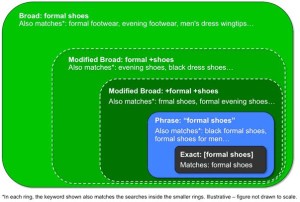There are many goals that you should keep track of when you are doing any kind of online marketing. These include things like return on investment (ROI), what your conversion rates are, and how the AdWords channel compares to others when you’re deciding how to allocate your marketing budget.
This post is about specific goals you should be setting within AdWords to make sure that you are getting the best bang for your buck within their paid marketing system. Here’s a quick summary:
- The goal of your account: To keep you organized.
- The goal of your ad: To get a click.
- The goal of your keyword: To trigger the proper ad so people will want to click.
- The goal of your ad group: To determine which is the most effective ad.
- The goal of your campaign: To maximize your budget and ROI on your ad spend.
#1- The goal of your account: To keep you organized
The first goal that you should set is having proper account structure. This may seem a little odd to set as a goal but it’s easily achievable and will help you reach all of your other goals more effectively. Below is an image of a well designed account structure:

There are three levels to a properly designed account structure:
- The campaign level,
- The ad group level,
- The quality score level
The campaign level allows you to differentiate and segment your campaigns based on particular campaign goals. These goals may include things like setting up a campaign to run for the holiday season, or having an ongoing campaign to promote a particular service or product.
The ad group level allows you to focus on particular landing pages within that campaign and keep your account organized. Each ad group should only have a handful of ads and a slightly larger handful of keywords to most effectively maximize your targeting within the ad group.
The bottom row we call the quality score level. The quality score level is the most important in regards to showing up in the Google auction and the Google search engine results page (SERP). There are three elements to this level: your keywords, your ad text, and your landing pages. The reason we have grouped them together is because all three components are taken into account when Google assigns a quality score to a particular keyword and determines where your ad will show up in the auction for your keywords.
Keeping your campaigns and accounts structured like this will help you greatly as you are trying to optimize your return on investment with your Google AdWords program. With the ability to have thousands of our groups and thousands of keywords per ad group can quickly get quite confusing unless you keep your accounts structured properly.
Ideally your website would be set up this way as well with a hierarchical structure that Google’s robots can easily read.
#2 – The goal of your ad: To get a click
The goal of an ad is to get the click. That’s it.
Your well written ad‘s job is to attract the right end user, to click on it ,and be driven through to your landing pages that will tell them all about your products and services, and convert them to customers. There are a number of different things you can do to improve the ads relevancy to the customers search query. The easiest of these is to utilize dynamic text insertion in your ad text. This is where you can specify that the keywords that people have typed into Google or what will show up in your ad text headline and body. This greatly improves relevancy and will help improve your quality score and reduce costs.
Bottom line is Google likes highly relevant results because it will enable them to serve a better end user experience to the searchers. They want people searching for things to come back to Google over and over again, and you can help them achieve their goals by writing effective ads.
#3 – The goal of your keyword: To trigger the proper ad so people will want to click
The goal of the keyword is to have your ad show when people are looking for your products and services. Google has a brilliant algorithm that associates what someone types into the search bar and what ads and results get shown to them. Your job, with the help of the keyword planner tool, is to figure out what people will put into the search bar and have your keywords target those searches.
Different keywords will trigger different ads and show in different auctions based on the match type that you choose. There are four basic types of keyword modifications: broad match, modified broad match, phrase match, and exact match. The more narrow your targeting, with broad match being the widest reach and exact match being the most narrow reach, the fewer times your ad will show. The default setting for all keywords is broad match so your ads show as much is possible but you have great control to limit the amount of times your ad is shown to target your end users more effectively.

#4 – The goal of your ad group: To determine which ad is the most effective ad
Within each campaign you will have different ad groups targeting traffic to different landing pages.
The goal of an ad group is to keep you organized, and to help find the highest converting landing pages with the corresponding ad text or that ad group. The ad group simply contains groups of similar ads. Within each ad group you should have similar keywords targeting those ads.
#5 – The goal of your campaign: To maximize your budget and ROI on your ad spend
What are the goals of your campaign? Is your goal to promote a particular product or service? Is it to take advantage of a particular external event like the holiday shopping season or a Black Friday / Cyber Monday sale?
The key thing to keep in mind is just setting a goal for your campaign. Each campaign has its own life-cycle. It should have a beginning, a middle, and an end. No campaign should go on unchanged forever.
On the campaign level you will control your budget, your targeting, and ideally keeping track of your conversion rate. To effectively keep track of your conversion rate you should link your AdWords accounts with your analytics accounts, and have the two communicating with each other.
The budget settings are by day so you should set a goal for what your conversion rate will be by day. But targeting settings include things like which network to target, where you are targeting geographically, what types of ads you will be serving, and the start and end date of your campaign.
Before you even start your campaign you should have an idea of where and when, and how much you spend on targeting any particular marketplace. An example of this type of targeting could be the following:
- Campaign: NYC Black Friday Sale
- Budget: $500 per day
- Network: Search Only
- Campaign Start Date: Nov 15
- Campaign End Date: Dec 1
- Ad Schedule: 8AM to 10PM Monday to Friday
- Geo: Radius Targeting 20 Miles around zip code 10118
- Devices: All, but exclude mobile.
Even just having something as simple as the outline above will keep you focused on your goals for this campaign.
A note about the quality score level
There are three elements that work hand-in-hand on the last level of your campaign structure to determine exactly how much you will pay per click in each auction. These elements are your keywords, your ad text, and your landing pages. These three elements are taken into account by the Google algorithm to determine how high you will show in the auction. If you have highly targeted keywords, highly targeted ad text, and landing pages that provide a great user experience based on the keywords they had typed into Google, all of these features will work together to give you a great quality score.
With a great quality score comes a reduced cost to show in the auction. So a bonus goal should be to improve your quality score so your ad clicks cost less.
Quick Goals Summary (re-ordered by importance):
- The goal of your ad: To get a click.
- The goal of your keyword: To trigger the proper ad so people will want to click.
- The goal of your ad group: To determine which is the most effective ad.
- The goal of your campaign: To maximize your budget and ROI on your ad spend.
- The goal of a good account structure: To improve your quality score, thus reducing costs.
About The Author
Dave Burnett
I help people make more money online.
Over the years I’ve had lots of fun working with thousands of brands and helping them distribute millions of promotional products and implement multinational rewards and incentive programs.
Now I’m helping great marketers turn their products and services into sustainable online businesses.
How can I help you?






